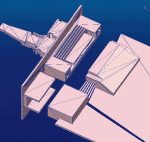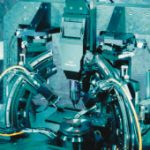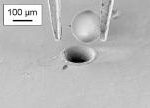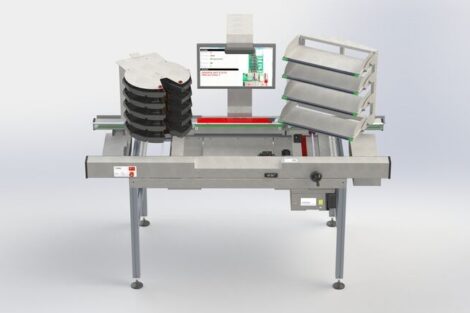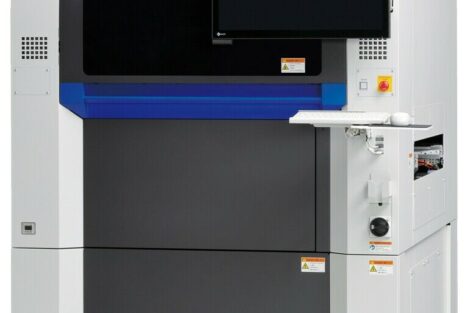The demand for highest data transfer rates in key telco and datacom applications leads to the necessity of electrical signals being increasingly replaced by light-based signal transmission. For the volume assembly of delicate electro-optical circuits, there is now a solution available for placing components within a minimum offset of 1 to 10 micron.
Dr.-Ing. Michael Burmeister, Harting Electro-Optics; Bernd Petersen, Fraunhofer Institute for Production Technology
Signal-processing components such as ICs of all kinds have normal electrical interconnects (galvanic coupling), requiring electro-optical converters in order to transmit a signal through a glass fiber. Inserting a glass fiber into a converter component demands utmost precision so that a maximum of light can be picked up. The more light is transfered, the higher the data quality and the stronger the signal. In response to the ever-increasing requirements, Harting is developing a concept that would permit economical assembly in high volumes. However, the components used in those electro-optical transmitter circuits are very small which poses difficulties in large numbers.
As data rates continue to sky-rocket, galvanically coupled I/Os as a transmission point are approaching their natural limits, both in terms of their physical properties and costs for achieving economically viable signal transmission. Today, a transmission rate of 5 to 10Gigabit/s is regarded as the limit for electrical contacts. This assumes a short transmission distance of only a few centimeters. However, if both extremely high data rates and transfer across long distances are simultaneously demanded, there is only one solution effective in use: optical transmission. For worldwide network concepts, there is already even the discussion about Petabit/s (million Gbit/s).
In terms of connection technology, pro-gress is being made by integrating electro-optical converters in connectors with the aim of combining a robust plug method with optical transmission technology. Within the framework of this development, Harting was commissioned to design a connector system with integrated electro-optical converters for a transmission rate of 10 Gigabit/s. The smart optical interconnect solution (SOIS) project places very high demands on production technology. Precise coupling of waveguides or fibers with transmitter or receiv-er components plays a decisive role in the transmission quality of an optical path. In addition to the usual demands in the field of microelectronics, micro-optical com-ponents must be positioned with ab-solute precision in order to attain the efficiency required.
Multi-mode glass fibers with core diameters of 50 or 62,5µm are generally usedto span short and medium distances, whereas single-mode fibers with a core diameter of 9µm are suited for long-distance transmission. The two key values for the quality of the electro-optical coupling are the distance between the fiber and semiconductor component, and the offset of the optical axis of the optical waveguide with regard to the light-emitting axis. Depending on the fiber, highly precise positioning with a maximum offset of 1 to 10µm is required. As the distance increases, attenuation increases significantly as of 150µm. This value was found in simulations in which various deviations and their effects on the coupling power loss were investigated using a multi-mode glass fiber with a core diameter of 62.5µm.
However, it is not just the required precision of positioning that represents an enormous challenge, but also the small size of the parts. Two types of optical transmitters are predominantly used in this application: edge emitters which are laser diodes that radiate light laterally, which are parallel to the layers in the semiconductor, and VCSELs (vertical cavity surface emitting lasers), which are called semiconductor lasers that emit the light from the surface. A VCSEL can be designed individually,but also as an array of several VCSELs,in which an individual component measures approximately 250 x 300 x 300µm. Accordingly, an array of 12 elements is only 1mm² in size. In SOIS technology developed by Harting, VCSELs are combined with glass fibers of 50 and 62,5µm for the transmission of signals at 10Gigabit/s across distances of up to 100m.
For optical signals to have sufficient power to be clearly detected at the end of the transmission path, positioning of the component and fiber must be optimized so that attenuation does not exceed 3dB. As shown through simulation, a maximum distance of about 150µm between the glass fiber and component is tolerable. At the same time, the offset between the optical axis of a VCSEL and of a glass fiber must not exceed 10µm. Therefore, the challenge to micro-assembly consists of positioning a component with an edge length of only 300µm with absolute precision in regard to a glass fiber having a core diameter of maximum 62.5µm.
In the past, optical transmission technology was primarily used for long distances, and only few and rather expensive components were available. Here, single-mode glass fibers are positioned actively on a component. We refer to an active assembly process if optimization of the fiber position is accomplished through an adjustment which measures the light decoupling intensity at the fiber to be positioned. Algorithms support optimization of the fiber position with respect to the component. The fiber is fixed as soon as the optimum has been achieved. This process can easily take several minutes per fiber. Although this time condition is still very common in manufacturing opto-electronic components, it is not acceptable for large series, and there is a clear need to catch up with microelectronic production.
Because the demand in numbers for such smart optical interconnect solutions (SOIS) is high, the company is working together with partners to develop a professional assembly concept for large-series production of opto-electronic components. The first step of this project will focus on multi-mode glass fibers. Currently available assembly systems, like those of Newport, permit positioning of components with an accuracy of 1µm or better. However, the set-up times are not fast enough for large-series production. Because of another setup concept, even faster cycles can be achieved. Nevertheless, problems can still arise that are unknown in other dimensions.
If a component is the size of a relatively large grain of dust, the gripper of the assembly machine may have difficulties releasing it during the assembly process. Sticking presents a common but frequently underestimated problem in micro-assembly. Due to the small size of micro-components, their weight force is frequently less than that of the other forces acting upon it. Components either continue to stick to the opened gripper or are even attracted to it from greater distances. Adhesion forces are the reason for these undesirable effects. This is a combinationof electrostatic forces of attraction, van-der-Waals forces, capillary forces and mechanical clinging between the gripper and object. As a result, an automated assembly process may be rendered difficult or even impossible.
A few general measures can help avoid or at least minimize sticking. For example, the gripping forces or, better said, the surface pressure between the component and gripper should be kept to a minimum. The jaws of the gripper should also be made of a mechanically hard material. As another protective measure, the surfaces of the gripper jaws should be roughened in order to minimize the number of points of contact between gripper and object. Last but not least: it is important to reduce air humidity as much as possible. Taking measures of this kind not only reduces mechanical clinging between gripper and object, but also inhibits the development of adhesion and van-der-Waals forces. Finally, electrostatic forces of attraction can be controlled by carefully grounding all electrically conductive components.
Despite these general measures, difficulties in releasing tiny parts may still occur. In that case, additional techniques need to be available to ensure that the sticking objects can be deposited safely and reproducibly. A small blast of compressed air suffices in most cases when using suction grasps. When using mechanical grasps, there are essentially four options available for depositing the components:
• Make use of the adhesion or attraction forces between the component and substrate (assembly surface) to overcome the forces of attraction between the gripper and component.
• Join the component and substrate while the element is being held in the desired position by the gripper. This so-called pick-and-join technique is very effective.
• Induce a relative movement between the component and gripper by either removing the component by drawing it over an edge or by having the gripper keep on moving after the component has already touched the substrate. This method is also very effective.
• Deposition supported by oscillation. Although this method requires an additional device for producing the oscillation, it is very effective.
However, these different methods are not equally well-suited for all assembly tasks. Therefore, the appropriate method must be selected in accordance with the individual task. Backed by the support of research institutes, Harting is developing an assembly technique permitting precision assembly of electro-optical components within an accuracy range of a few micrometers, to build the SOIS product. This involves breaking new ground in the field of optical measurement in addition to solving positioning problems and developing suitable gripper technologies. Constructing a small series of SOIS components is the next step. The results obtained thus far are very promising. The German Fraunhofer Institute for Production Technology (IPT) – one of these partners – pursues the goal of developing production solutions for small and medium-sized companies. One area is pre-cision and micro-technology, especially micro-production, micro-assembly and designing and manufacturing optical systems.
Zusammenfassung
Höchst-Datenraten von 10 Gbit bis in den Petabit-Bereich (eine Million Gbit) sind nur noch mit elektro-optischen Systemen übertragbar. Zum Einkopeln solcher Signale von Laserdioden in Glasfasern müssen Offset-Toleranzen von maximal 10 ìm eingehalten werden, damit die Signaldämpfung akzeptierbar bleibt. Mit Mikro-Montagetechniken lassen sich diese hohen Anforderungen erfüllen.
Résumé
Le transfert de données à des vitesses extrêmes de 10 Gbits, pouvant aller jusqu’au Petabit (un million de Gbits), n’est possible qu’avec des systèmes électro-optiques. Le couplage de tels signaux entre les diodes laser et les fibres de verre implique le respect de tolérances de 10 ìm au maximum pour que l’atténuation du signal reste acceptable. Les micro-techniques de montage permettent de remplir ces sévères critères.
Sommario
Delle velocità di trasmissione dati da 10 Gbit sino a dei Petabit (un milione di Gbit) sono realizzabili unicamente con sistemi elettro-ottici. Per la canalizzazione di tali dati dai diodi laser alle fibre ottiche devono essere rispettate delle tolleranze offset massime di 10 ìm, al fine di mantenere ad un livello accettabile lo smorzamento del segnale. Le tecniche di micromontaggio permettono di soddisfare questi severi requisiti.
Flexible PCBs are key in Harting’s SOIS project (smart optical interconnect solution), to serve as substrate and to provide a reliable basis for 250 plug cycles. A flex-PCB is being used for contacting between daughterboard and sub-board for the electro-optical converter. In telecom and datacom applications a useful product life of at least 15 years is required, at an availability of 99.999% (5 minutes of downtime per year), and an ambient temperature of 80°C for such a system.
Share:



